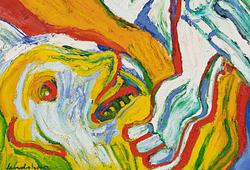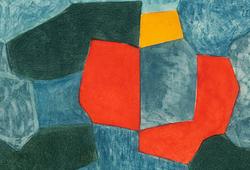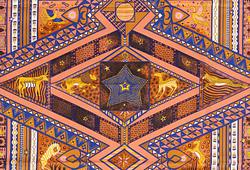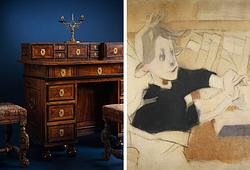Jean-Philippe de La Roche
Portrait of Barbara Campanini (1721-1799), known as La Barbarina, dancing in a garden, probably in Versailles
Uppfodrad duk 68,5 x 56,5 cm.
Tilläggslista
Olof Granberg, "Svenska konstsamlingarnas historia" II, 1930, Bil XVIII, sid 238. Åkerö bouppteckning efter Carl Gustaf Tessin 1770, under Portraiter i Olja
Proveniens
Commissioned in Paris in 1742 by Carl Gustaf Tessin (1695-1770), Swedish ambassador to France;
Sent by him from Paris to Stockholm in 1742;
Between 1744 and 1757 displayed in the mezzanine in the Tessin palace, Stockholm:
In 1757 transferred to Åkerö in the district of Södermanland, Tessin´s newly built country estate, where hung in his wife´s, Ulla Sparre´s bedroom;
his sale, Åkerö, 16 February 1771, where purchased by Tessin´s niece and sole inheritor, count Fredrik Sparre (†1805);
his sale, Stockholm, The Royal Academy, May 1786, lot 14 (bought back by Sparre); on display in his townhouse in Stockholm;
again transferred to Åkerö where mentioned in an inventory from 1805, where displayed in the Library wing in the Captain´s room;
thence by descent until the late nineteenth century
Private Swedish collection until 2009
Litteratur
Sale Catalogue, Förteckning På hwad i synnerhet förtjenar utmärkas, bland de Saker, som förekomma wid Auction på Åkeröö den 4:de och följande dagar til och med den 16.de i Februari Månad, 1771 såsom - - - af Portraiter i Olja - - -, ´Mademoiselle Barbarini, nu mera madame de Coccey, målat af Le Brun, Natiers systerson och Eleve. Dito [förylld Bildthuggare=Ram]´ [Mademoiselle Barbarini, now known as madame de Coccey, painted by Le Brun, Nattiers nephew and pupil]
Sale catalogue, Catalogue d´une collection [...] Dont la Vente au plus offrant se sera le du mois de may 1786, et jours de relevée, dans la Grand Salle d´Assemblée de l´Académie Royale de Peinture et de Sculpture á Stockholm. Premiere Partie, Stockholm 1785, p. 5 ´I, De Tableaux et Portraits, no. 14´Mad:lle Barbarini, depuis Mad:e Coccei, en Danseuse, peintre à l´huile. Cadre doré et sculpté.´
N.F. Sander, Bidrag till tafvelgalleriets historia, I, Stockholm, Nationalmuseum, 1872, Appendix No. 1, p. 60, No. 117; Appendix No. 2, p. 66
G. von Proschwitz, Tableaux de Paris, et de la cour de France 1739-1742, Stockholm, 1984, p. 304, quoting a letter from Tessin to his wife countess Ulla Sparre dated 12/23 March 1742 [...] ´Nos portraits augement: Jáy celuy de la petite Barberine, qui vous enchantera; Vos la Verré danser ornée de tous les appas qui ont enchainés les Durefort, les Lomellini, les Cantimir et les Roth. Ce pauvre Embrion est malade d´une Hydropisie au nez qu´il a gros et rempli d´eau comme la Samaritaine du Pont neuf [..]´
Olof Granberg, "Svenska konstsamlingarnas historia" II, 1930, Bil XVIII, sid 238. Åkerö bouppteckning efter Carl Gustaf Tessin 1770, under Portraiter i Olja
G. von Proschwitz, Carl Gustaf Tessin i Paris, Konst och politik, Stockholm, 2002, p. 274, Tessin´s wife´s reply dated´Sundby [Sweden] 3 Aprill 1742´ ´Jag är mycket glad att Du har den lilla Barbarinis porträtt´ [I am very happy that you have the little Barbarini´s portrait). B. von Haslingen, Tessinska Palatset under 300 år, privatbostad, överståthållarebostad, landshövdingeresidens, Stockholm, 2002, pp. 196-206, room 226 or 232.
Manuscripts:
List of items belonging to Count Carl Gustaf Tessin sent from Paris to Stockholm 1742, where listed as´Mad:lle Barbarinis Portrait af la Rochee´, valued to 400 livres (MS, The Royal Library, Stockholm, HS, p. 12)
Inventory of the Tessin Palace, Stockholm, 1744 as´La Barbarinis Portrait dantsande i en trägård, målad af la Roche, förgylld bildhuggare ram´ (MS, The Royal Library, Stockholm, Inventarium 1744, fol. 47)
Inventory of Åkerö Castle, District of Södermanland, Sweden, 1757 as´1 st. Portraitt i mycket mindre än naturen, halfbild, mlle Barberini /: numera madame de la Cocces:/ dantzande i theatralisk klädning målad af le Brun, Nattiers syterson och eleve, förgylld bildhuggare ram´ (MS, The Royal Library, Stockholm, Inventarium Åkerö 1757, fol. 47) Listed in an inventory from Åkerö in 1763 as displayed in Ulla Sparre´s bedroom, Tessin´s wife, where valued to 240 daler silvercoins (MS, The Royal Library, Stockholm, Inventarium1763, fol. 858)
Inventory of Countess Ulla Sparre´s deceased estate, Åkerö 1769 (RA, Svea hovrätt, adliga bouppteckningar, grevinnans sängkammare, fol. 104)
Inventory of Count Carl Gustaf Tessin´s deceased estate, Åkerö 1770 as ´Mademoiselle Barberini numera madame de Coice, dantzande uti Theatralisk klädning, hel bild,mycket mindre än naturen, målad af le Brun, Nattiers systerson och eleve, förgylld bildhuggare ram´, where valued to 72 daler silvermynt (RA, Svea hovrätt, adliga bouppteckningar, i olja, fru grefwinnans sängkammare, fol. 122r).
Inventory of Fredrik Sparre (died 1805), Åkerö, as ´Mad:lle Barbarini en Danseuise, hel bild litet Portrait målad af ---bred förgyld Bildhuggare ram´,where valued to 360 daler silvermynt (MS, The Royal Library, Stockholm, Inventory 1772, grevinnans sängkammare, fol. 25) Inventory of Fredrik Sparre´s desceased estate at Åkerö in 1805 as mademoiselle Barbarinis portraitt i Dantsande ställning (RA, Svea hovrätt, adliga bouppteckningar, Åkerö, biblioteksflygeln, Captains rum)
Övrig information
The present newly discovered painting of the celebrated eighteenth century ballet dancer was commissioned in 1742 by Count Carl Gustaf Tessin (1695-1770), Swedish ambassador to Paris between 1739-42. During his stay in Paris, Tessin commissioned several portraits from Jean-Marc Nattier (1685-1766), the most thought after portrait painter in Paris at the time. Amongst them were portraits of his wife, Ulrika Lovisa Sparre of Sundby (1711-68) (Musée du Louvre) and his niece, Charlotta Sparre (1719-1795) (National Gallery of Ireland).
In 1741, Tessin's own portrait was painted by Louise Tocqué (1696-1772), Nattier´s son-in-law (Nationalmuseum, Stockholm).
Jean-Philippe de La Roche, Peintre du Cabinet du Roi, was brother-in-law to Nattier and in the 1740s´ worked in his studio. In 1724 Nattier had married his sister, Marie Madeleine de La Roche (1708-1742). Their father, Pierre de La Roche (1638-1715), married to Marie-Anne Levasseur, was one of King Louis XIV:s Muscateers´. By 1742, Nattier was in high demand. To ease the workload, de La Roche, as well as official court painters such as Coqueret, Prevost, Frey and Hellart helped in producing replica portraits. The present picture is de La Roche´s earliest known work and his first known independent work. Few works by him are known. In 1752 he was payed 750 livres for copying five Royal portraits and in 1754, 500 livres for a copy of a portrait of King Louis XV. In 1757 he painted two pictures of unknown subjects for the Oratory of Madame de Pompadour in the Chapel in Versailles. The same year the Dauphin (Louis XVI) commissioned him to copy a portrait of his wife for countess de Bellegarde (Chateau de Versailles), which hitherto constituted the only known picture by La Roche. In 1761, together with Coqueret, Prevost, and Hellart, he decorated the Chinese cabinet of Queen Maria Lezczynska. La Roche died in Versailles 1767.
The present painting is the only known portrait of La Barbarina painted in France and one of the earliest known depictions of her. It was commissioned before March 1742 as it is mentioned in a letter that month to Tessin from his wife (G. Von Proschwitz, 1984, op. cit.). Tessin attended at least one of La Barbarini´s performances in Paris in 1739 and became one of her great admirers. Here La Barbarina is portrayed in a park in a dancing pose. The park is most likely intended to allude to the park of Versailles, where she is known to have performed. Other artists who portrayed her include Rosalba Carriera, c. 1739 (Staatlische Kunstsammlungen Dresden), Antoine Pesne, 1745 (Schloss Charlottenburg, Potsdam, Germany), and posthumously, Adolph von Menzel. An engraving by Hogarth, The Charmers of the Age, also depicts her performing a dance together with the ballet dancer Philip Denoyer. Hogarth´s engraving, conceived in 1740, was, however, first published in 1787.
Barbara Campanini (Parma 1721-1799 Castle Barschau, Schlesia), known as La Barbarini, was the most renowned ballerina of her time. At the age of 10, she studied at the Teatro Farnese under Antonio Rinaldi, known as Fossano. She began her dancing career at the Académie Royale de Musique in Paris in 1739 where she made her stage debut in Jean-Philippe Rameau´s (1735-1764) ballet Les fêtes d’Hébé ou les Talents lyriques, which premiered 14 July, which included four solodances written especially for her. The ballet was an enormous success and over 50 performances were given. La Barbarina also danced at Fontainebleau and Versailles and was presented to King Louis XV. In 1740 she travelled to London where she performed at Covent Garden in ballets such as Italian Peasants, Mars and Venus and Le Tirolesi. At Cliveden in 1740, she appeared before Prince Frederick of Wales and his wife Augusta of Brunswick. She returned to Paris in 1741 via Vienna where she performed in L´empire de l´amour and Les festes greques et romaines. According to Voltaire, a secret to her enormous success was her manly legs, which made her capable of unusually large jumps. In 1744, La Barbarina was employed by Fredrik the Great of Prussia, who had seen her perform in Paris, and she moved to Berlin. There Fredrik the Great soon became one of her many lovers (he had been preceded by the Prince of Savoy-Carignano, the Prince de Conti, the Duc de Durfort and the British Peer the Earl of Arundel). La Barbarina was given a palace where she entertained on a high social level. In 1745, Fredrik the Great commissioned his court painter Antoine Pesne to paint her portrait, which on competion was then hung in his study.
La Barbarina´s life following her move to Berlin is a tale of professional success mixed with a scandalous private life carried out amongst the social elite of Europe. Fredrik the Great´s passion for La Barbarina was not mutual. She soon escaped with another lover, Lord Stuart Mackenzie, to Venice. Fredrik the Great, however, execised his diplomatic power, and she was escorted back to Berlin by his military aid. In 1748, she secretly got engaged to Charles-Louis de Coccei, the son of his prime minister. On discovering this, she fell out of favour with Fredrik the Great and she was forced to sell her palace. In 1759, the couple divorced. In 1788, La Barbarina was made countess Campanini by Fredrik the Great´s successor, his nephew, Frederick William II of Prussia. In her will she donated her money by will to a foundation for poor noblewomen, both catholic and protestant, which lasted until World War I. Fascination with La Barbarina has lasted well beyond her lifetime and in 1920 it inspired the film, Die Tänzerin Barbarini and in 1935 the ballet, Barbarina (for further reading see W. Röseler, Die Barbarina, 1890; J. J. Olivier and W. Norbert, Barbarina Campanini, 1909; M. Clarce & C. Crisp, Ballet in Art, from the Renaissance to the Present,1978, p. 26, no. 24; International Encyclopedia of Dance, Vol. 1, 1998 and P. H. Highfill Jr, K. A. Burnim & E. A. Langhaus, Biographical Dictionary of Actors, Actresses, Musicians, Dancers, Managers, Other Stage Personell 1660-1800 in London, Vol. 3.).
Bukowskis is grateful to Roger de Robelin, the reknown expert on Tessin, for his assistance in the cataloguing of this lot.

































